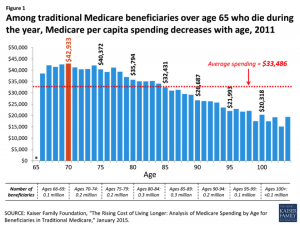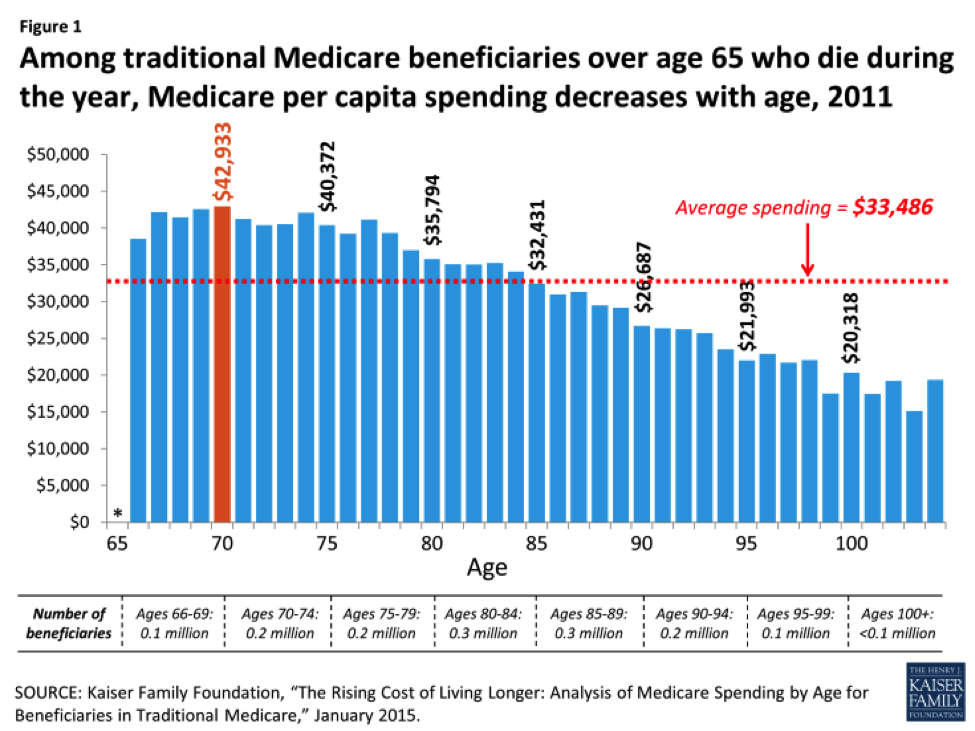By John C. Goodman
Originally posted on Forbes, November 2015.
Every year about 5 percent of Medicare enrollees die. And before they die, Medicare spends a great deal of money on them.
We spend more than one in every four Medicare dollars (27 percent) on patients in their last year of life. We spend almost one third (32 percent) on chronically ill patients in the last two years of life.
Is this wise public policy?
First some good news. The fraction of Medicare dollars spent on people near the end of their lives has remained roughly constant over the past several decades. So things aren’t getting worse over time. Furthermore, there is some evidence that the spending decisions are not entirely irrational.
As the chart below shows, we are spending about $33,000 on the average Medicare patient who dies over the course of a year. But we spend twice as much on 70-year-olds as we are spending on 90-year-olds. This suggests that we are devoting more resources to patients who might have a chance to live another decade or two rather than on patients who are likely to die in the near future, regardless of what we do.
Still, how we treat patients who are about to die has caused more than one observer to cry foul. Atul Gawande, for example, has writen a whole book on the subject.
One doctor, who blogs under the pseudonym Scott Alexander at the website Slate Star Codex, describes how many of his patients leave the world:
Old, limbless, bedridden, ulcerated, in a puddle of waste, gasping for breath, loopy on morphine, hopelessly demented in a sterile hospital room.
He gives some specifics – and be forewarned, this gets gruesome:
You will become bedridden, unable to walk or even to turn yourself over. You will become completely dependent on nurse assistants to intermittently shift your position to avoid pressure ulcers. When they inevitably slip up, your skin develops huge incurable sores that can sometimes erode all the way to the bone, and which are perpetually infected with foul-smelling bacteria. Your limbs will become practically vestigial organs, like the appendix, and when your vascular disease gets too bad, one or more will be amputated, sacrifices to save the host. Urinary and fecal continence disappear somewhere in the process, so you’re either connected to catheters or else spend a while every day lying in a puddle of your own wastes until the nurses can help you out.
In “How Doctors Die,” Dr. Ken Murray, writes: “I cannot count the number of times fellow physicians have told me, in words that vary only slightly, ‘Promise me if you find me like this that you’ll kill me.’ They mean it.”
California Gov. Jerry Brown just signed legislation creating a right to physician-assisted suicide. Similar laws already are on the books in the states of Montana, Oregon, Vermont and Washington. New Mexico’s proposal is caught up in the courts.
I have no problem with such laws, but they’re really only half-measures. For every patient who might request physician-assisted suicide there are thousands more whose lives are being prolonged unnecessarily by hospital bureaucracies.
For example, thousands of patients both verbally and in writing request “do not resuscitate” (DNR) designations. Basically this means, “If I am in pain, have no quality of life and I’m incapable of communicating intelligently with you, don’t keep me alive by hooking me up to a respirator, feeding me through a tube or breaking my ribs with CPR so that I will continue in that condition.”
Yet hospitals systematically deny such requests if even one relative objects. The relative may be someone the patient hasn’t seen in years. She may be someone the patient doesn’t even like.
The biggest problem here is economics. People are making decisions, but they do not bear the costs of those decisions. Medicare bears the cost. Which means, we taxpayers pay the cost.
Loyal readers know that I have been critical of the claim that the health care systems of other countries are superior to our own. But this is one area where some other countries outperform us in spades. As I wrote at the Health Affairs blog:
- In Germany and Austria, a cash payment is made to people eligible for long-term care — with few strings attached and little oversight on how the money is used.
- In England and the Netherlands, the disabled and the elderly manage their own budgets, choosing the services and providers that meet their needs.
These arrangements tend to be win-win: saving money for the government and improving the wellbeing of the patients.
- In Germany, long-term care patients are given 50% less than what would have been spent if they agree to manage their own budgets. In the Netherlands, spending is 30% less. In England, long-term care services purchased by individuals cost from 20% to 40% less than equivalent services purchased by local governments….
- In the Netherlands, close to 80 percent of disabled and elderly participants who were eligible for long-term care services and opted for a personal budget had a positive assessment of the services they received, compared with less than 40% in traditional care.
- In England, 79% of those who employ a personal assistant were very satisfied with the care and support they received, compared to only 26% in traditional care.
In the United States we don’t give money to patients and their families. We give money to the medical industrial complex. And here is a good principle to remember: in health care, every dollar of wasteful spending is a dollar of income to someone.
But as it turns out, we actually are doing something similar to what other countries are doing in Medicaid. It’s just not used for end-of-life care. The program is called Cash and Counseling and it allows home-bound disabled patients to manage their own budgets. (See this Commonwealth Fund study).
Remarkably, satisfaction rates in the Cash and Counseling programs have hovered in the high 90 percentiles. You can’t find satisfaction rates like that in any health care system in the world.

This article was originally posted at Forbes on November 30, 2015.

0 Comments